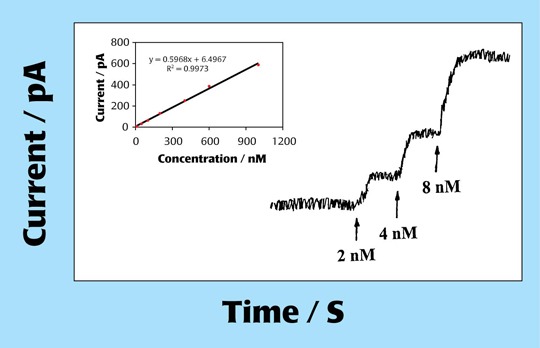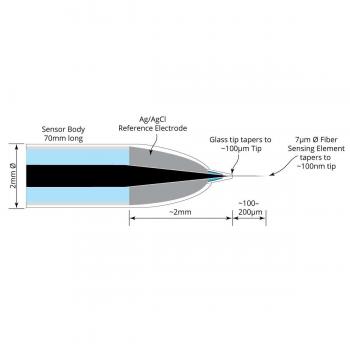ISO-NOPNM Nitric Oxide Sensor - 100nm
The WPI's ISO-NOPNM nitric oxide sensor has a diameter of 100 nm and can be used to measure NO at the cellular level.
- Overview
- Specifications
- References
- Links
The tiniest NO NanoSensor was created to monitor NO at the cellular level.
Key Features
- 0.5 pA/nM NO selectivity
- Quick reaction time: < 3 seconds
- Extremely sensitive
- For use with Apollo1000, Apollo4000, TBR4100 and TBR1025
- Requires cable 91580 (sold separate)
- Package of 3
Benefits
- The detection limit for NO is less than 0.5 nM, and the tip diameter is 100 nm
Applications
- Evaluation of NO at the cellular level
Measurement of NO at the Cellular Level
The ISO-NOPNM NanoSensor is without a doubt the tiniest and most sensitive NO sensor in the world, with a tip diameter of only 100nm (0.1 µm) and a detection limit for NO of less than 0.5nM.

NO nanosensor (ISO-NOPNM) amperometric response to injections of 2nM, 4nM, and 8nM NO into 0.1M PBS (pH=7.4).
Design
The ISO-NOPNM is based on a cutting-edge design in which the NO-sensing component is a composite graphite nanofiber that has been electrochemically "activated." A special multi-layered NO-selective membrane is subsequently used to modify the Nanosensor's surface. The ISO-response NOPNM's to adding NO at increasing concentrations of nanomolarity is shown in the figure above. The ISO-ultra-low NOPNM's noise (0.5pA) allows for a detection limit of only 0.5nM NO. ISO-NOPNM has a response time of under 3 seconds.
Selectivity of WPI's NO Sensors
Other reactive species that are expected to be present in the measuring environment shouldn't affect the NO sensor's performance. Standard Nafion-coated carbon fiber NO sensors react strongly to such species. The innovative surface membrane used by WPI's NO sensor technology amplifies the reaction to NO while suppressing responses to a wide spectrum of reactive species, such as nitrite, ascorbic acid, hydrogen peroxide, catecolamines, and many more.
The instrument was used in these investigations:
- Effects of vasodilators and perfusion pressure on coronary flow and simultaneous release of nitric oxide from guinea pig isolated hearts
S. Fujita, D.L. Roerig, Z.J. Bosnjak, D.F. Stowe
Cardiovascular Research 38. 1998: 655-667
You can also visit site of the manufacturer.


